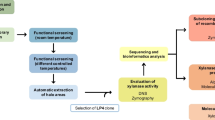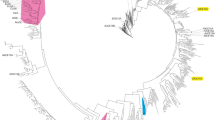Abstract
The ceIV1 gene encoding a secreted cellulase (CelV1) of Erwinia carotovora subsp. carotovora SCC3193 was cloned and its nucleotide sequence determined. The gene contains an open reading frame of 1511 by and codes for an exported protein of 504 amino acids. The predicted amino acid sequence of Ce1V1 was highly similar to that of CeIV of another E. c. subsp. carotovora strain SCRI193 but completely different from the previously characterized cellulase, CelS, of the strain SCC3193. Gene fusions to the lacZ reporter were employed to characterize the regulation of celV1 and celS. Both genes are coordinately induced in a growth phase-dependent manner and are catabolite repressed. Expression of celV1 but not celS was stimulated by plant extracts. The celS gene was expressed at a much lower level than celV1 under all conditions tested. Inactivation of the celV1 gene in E. c. subsp. carotovora strain SCC3193 by marker exchange showed that celV1 encodes the major cellulase of strain SCC3193, as the resulting mutant strain SCC6001 was devoid of cellulase activity. Ce1Vl mutants exhibited reduced virulence suggesting that CelV1, although not absolutely required for pathogenicity, enhances the ability of strain SCC3193 to macerate plant tissue. Inactivation of the celS gene in the celV1 mutant did not lead to any further decrease in virulence.
Similar content being viewed by others
References
Andro T, Chambost JP, Katonjansky A, Catteneo J, Bertheam Y, Barras F, van Gijsegem F, Colleno A (1984) Mutants of Erwinia chrysanthemi defective in secretion of pectinase and cellulase. J Bacteriol 160:1199–1203
Ausubel FM, Brent R, Kingston RE, Moore DD, Seidman JG, Smith JA, Struhl K. (1987) Current protocols in molecular biology. John Wiley & Sons, New York
Aymeric J-L, Guiseppi A, Pascal M-C, Chippaux M (1988) Mapping and regulation of the cel genes in Erwinia chrysanthemi. Mol Gen Genet 211:95–101
Beguin P (1990) Molecular biology of cellulose degradation. Annu Rev Microbiol 4:4219–248
Biely P, Mislovicova D, Toman R (1985) Soluble chromogenic substrates for the assay of endo-1,4-β-xylanases and endo-1,4β-glycanases. Anal Biochem 144:142–146
Boccara M, Aymeric J-L, Camus C (1994) Role of endoglucanases in Erwinia chrysanthemi 3937 virulence on Sauntpaulia ionantha. J Bacteriol 176:1524–1526
Boyer M-H, Chambost JP, Magnan M, Cattaneo J (1987) Characterization of a new endoglucanase from Erwinia chrysanthemi. Eur J Biochem 162:311–316
Chatterjee AK, McEvoy JL, Murata H, Collmer A (1991) Regulation of the production of pectinases and other extracellular enzymes in the soft-rot Erwinia spp. In: Molecular strategies of pathogens and host plants. Patil SS, Ouchi S, Mills D, Vance C (eds) Springer, New York
Collmer A, Keen NT (1986) The role of pectic enzymes in plant pathogenesis. Annu Rev Phytopathol 24:383–409
Cooper VJC, Salmond GPC (1993) Molecular analysis of the major cellulase (CeIV) of Erwinia carotovora: evidence for an evolutionary “mix-and-match” of enzyme domains. Mol Gen Genet 241:341–350
Gilkes NR, Henrissat B, Kilburn DG, Miller RC, Warren RAJ (1991) Domains in microbial β-1,4-glycanases: sequence conservation, function, and enzyme families. Microbiol Rev 55:303–315
Gilman M (1987) In: Ausubel FM, Brent R, Kingston RE, Moore DD, Seidman JG, Smith JA, Stuhl K (eds) Current protocols in molecular biology. John Wiley & Sons, New York, 4.4.1–4.4.4
Gough CL, Dow JM, Barber CE, Daniels MJ (1988) Cloning of two endoglucanase genes of Xanthomonas campestris pv. campestris:analysis of the role of the major endoglucanase in pathogenesis. Mol Plant-Microbe Interact 1:257–281
Guiseppi A, Cami B, Aymeric JL, Ball Y (1988) Homology between endoglucanase Z of Erwinia chrysanthemi and endoglucanases of Bacillus subtilis and alkalophilic Bacillus. Mol Microbiol 2:1591–1604
Guiseppi A, Aymeric JL, Cami B, Barras F, Creuzet N (1991) Sequence analysis of the cellulase-encoding gene of Erwinia chrysanthemi: a possible case of interspecies gene transfer. Gene 106:109–114
von Heijne G (1983) Patterns of amino acid signal sequence cleavage sites. Eur J Biochem 133:17–21
Henikoff S (1984) Unidirectional digestion with exonuclease III creates targeted breakpoints for DNA sequencing. Gene 28:351–359
Henrissat B, Claeyssens M, Tomme P, Lemesle L, Mornon J-P (1989) Cellulase families revealed by hydrophobic cluster analysis. Gene 81:83–95
Hinton JCD, Gill DR, Lalo D, Plastow GS, Salmond GPC (1990) Sequence of the peh gene of Erwinia carotovora: homology between Erwinia and plant enzymes. Mol Microbiol 4:1029–1036
Horikoshi K, Fukumori F (1988) Modification and expression of alkaline cellulase genes of alkalophilic Bacillus strains. In: Aubert JP, Beguin P, Millet J (eds) Biochemistry and genetics of cellulose degradation. Academic Press, New York, pp 203–217
Karlsson M-B, Pirhonen M, Saarilahti HT, Palva ET (1991) Molecular cloning of ompRS, a regulatory locus controlling production of outer membrane proteins in Erwinia carotovora subsp. carotovora. Mol Gen Genet 226:353–360
Knowles J, Lehtovaara P, Teeri T (1987) Cellulase genes and their families. Trends Biotehnol 5:255–261
Kotoujansky A (1987). Molecular genetics of pathogenesis by soft-rot erwinias. Annu Rev Phytopathol 25:405–430
Laemmli UK (1970) Cleavage of structural proteins during the assembly of the head of bacteriophage T4. Nature 227:680–685
Lång H, Palva ET (1993) The ompS gene of Vibrio cholerae encodes a growth phase-dependent maltoporin. Mol Microbiol 10:891–901
Maniatis T, Fritsch EF, Sambrook J (1982) Molecular cloning. A laboratory manual. Cold Spring Harbor Laboratory, Cold Spring Harbor, New York.
Miller JH (1972) Experiments in molecular genetics. Cold Spring Harbor Laboratory, Cold Spring Harbor, New York.
Murata H, McEvoy J, Chatterjee A, Collmer A, Chatterjee AK (1991) Molecular cloning of an aepA gene that activates production of extracellular pectolytic, cellulolytic, and proteolytic enzymes in Erwinia carotovora subsp. carotovora. Mol Plant-Microbe Interact 4:239–246
Palva ET (1978) Major outer membrane protein in Salmonella typhimurium induced by maltose. J Bacteriol 136:286–294
Perombelon MCM, Kelman A (1980) Ecology of the soft rot erwinias. Annu Rev Phytopathol 18:361–387
Penttilä M, Lehtovaara P, Nevalainen H, Bhikhabhai R, Knowles J (1986) Homology between cellulase genes of Trichoderma reesei: complete nucleotide sequence of the endoglucanase gene I. Gene 45:253–263
Pirhonen M, Saarilahti H, Karlsson M-B, Palva ET (1991) Identification of pathogenicity determinants of Erwinia carotovora subspecies carotovora by transposon mutagenesis. Mol Plant-Microbe Interact 4:276–283
Pirhonen M, Flego D, Heikinheimo R, Palva ET (1993) A small diffusible signal molecule is responsible for the global control of virulence and exoenzyme production in plant pathogen Erwinia carotovora. EMBO J 12:2467–2476
Py B, Bortoli-German I, Haiech I, Chippaux M, Barras F (1991) Cellulase EG2 of Erwinia chysanthemi: structural organization and importance of His 98 and Glu 133 residues for catalysis. Prot Eng 4:325–333
Roberts DP, Denny TP, Schell MA (1988) Cloning of the egl gene of Pseudomonas solanacearum and analysis of its role in phytopathogenicity. J Bacteriol 170:1445–1451
Rosenberg M, Court D (1979) Regulatory sequences involved in the promotion and termination of RNA transcription. Annu Rev Genet 13:319–353
Saarilahti HT, Henrissat B, Palva ET (1990) Ce1S: a novel endoglucanase identified from Erwinia carotovora subsp. carotovora. Gene 90:9–14
Saarilahti HT, Pirhonen M, Karlsson M-J, Flego D, Palva ET (1992) Expression of pehA-bla gene fusion in Erwinia carotovora subsp. carotovora and isolation of regulatory mutants affecting polygalacturonase production. Mol Gen Genet 234:81–88
Saloheimo M, Lehtovaara P, Penttilä M., Teeri TT, Stahlberg J (1988) EGIII, a new endoglucanase from Trichoderma reesei, and the characterization of both gene and enzyme. Gene 63:11–21
Sanger F, Nicklen S, Caulson A (1977) DNA sequencing with chain terminating inhibitors. Proc Natl Acad Sci USA 74:5463–5467
Stephens GJ, Wood RKS (1975) Killing of protoplasts by soft-rot bacteria. Physiol Plant Pathol 5:165–181
Walker DS, Reeves PJ, Salmond GPC (1994) The major cellulase, CelV of Erwinia carotovora subsp. carotovora is an important soft rot virulence factor. Mol Plant-Microbe Interact 7:425–431
Author information
Authors and Affiliations
Additional information
Communicated by A. Kondorosi
Rights and permissions
About this article
Cite this article
Mäe, A., Heikinheimo, R. & Palva, E.T. Structure and regulation of the Erwinia carotovora subspecies carotovora SCC3193 cellulase gene celV1 and the role of cellulase in phytopathogenicity. Molec. Gen. Genet. 247, 17–26 (1995). https://doi.org/10.1007/BF00425817
Received:
Accepted:
Published:
Issue Date:
DOI: https://doi.org/10.1007/BF00425817




